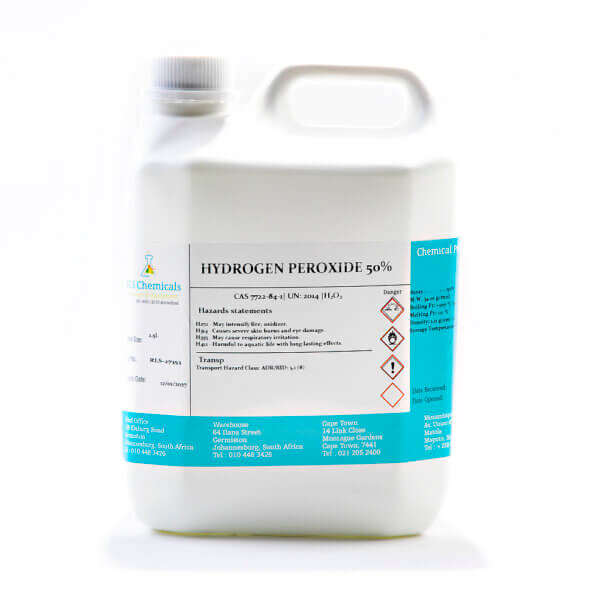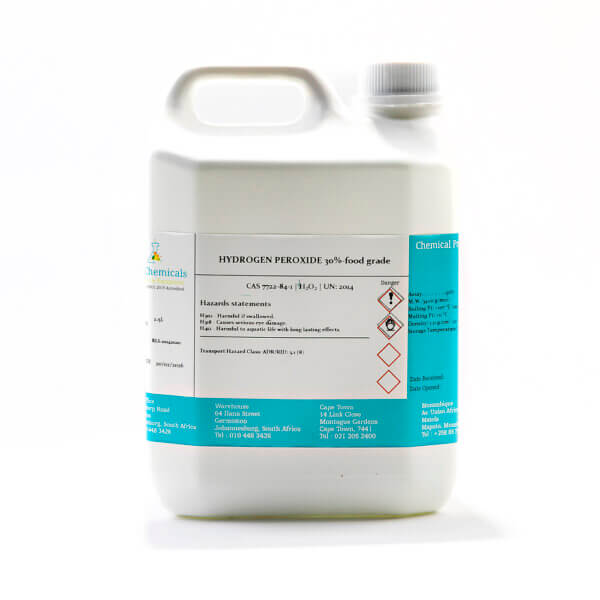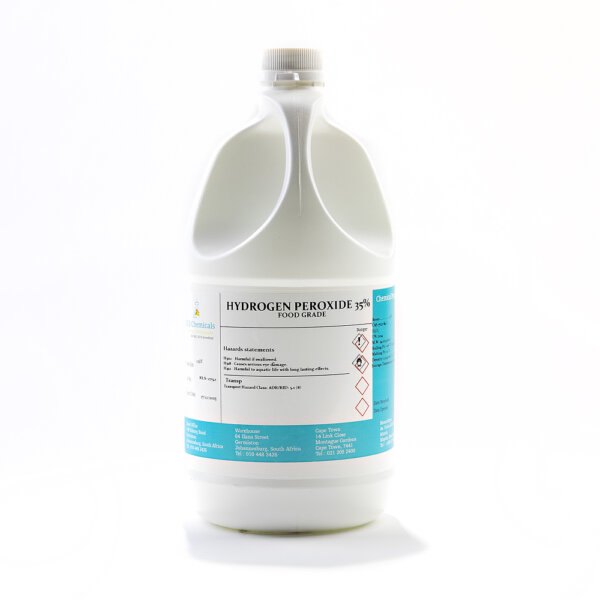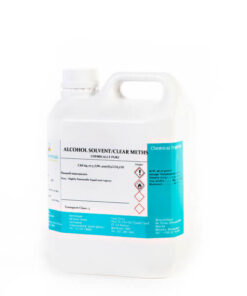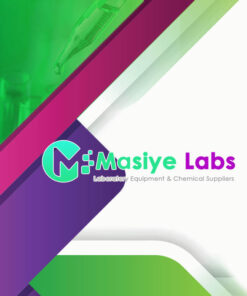Hydrogen Peroxide 35% Food Grade – 2,5l
R188.18 Ex VAT
Hydrogen Peroxide 35% Food Grade – 2,5l
Hydrogen Peroxide 35% Food Grade – Identification of Product Chemical Code: CHE-H13 Chemical Name: Hydrogen Peroxide (35%) Chemical Grade: Food Grade Chemical Formula: H₂O₂ Chemical Weight: 34,01 g/mol CAS No: 7722-84-1 Chemical Synonyms: Hydrogen Peroxide Food Grade – Hazards Identification REACH No: No Data Available Signal Word: Danger Supplemental Hazard Information: Additional Hazard Information: This mixture contains no components considered to be either persistent, bio-accumulative and toxic (PBT), or very persistent and very bio-accumulative (vPvB) at levels of 0.1% or higher. Hydrogen Peroxide Food Grade – Hazards statements H302 – Harmful if swallowed. H318 – Causes serious eye damage. H412 – Harmful to aquatic life with long lasting effects. Hydrogen Peroxide Food Grade – Precautionary statements P273 – Avoid release to the environment. P280 – Wear eye protection/ face protection. P301 + P312 + P330 – IF SWALLOWED: Call a POISON CENTER/doctor if you feel unwell. Rinse mouth. P305 + P351 + P338 + P310 – IF IN EYES: Rinse cautiously with water for several minutes. Remove contact lenses, if present and easy to do. Continue rinsing. Immediately call a POISON CENTER/doctor. Hydrogen Peroxide Food Grade – Composition of Chemical Chemical Formula: H₂O₂ EC No 1272/2008: No Data Available Hydrogen Peroxide Food Grade – First Aid Measures General Advice: Consult a physician. Show this safety data sheet to the doctor in attendance. If: Inhaled: If breathed in, move person into fresh air. If not breathing, give artificial respiration. Consult a physician. If: Skin Contact: Take off contaminated clothing and shoes immediately. Wash off with soap and plenty of water. Consult a physician. If: Eye Contac: Rinse thoroughly with plenty of water for at least 15 minutes and consult a physician. If: Swallowed: Do NOT induce vomiting. Never give anything by mouth to an unconscious person. Rinse mouth with water. Consult a physician. Important Symptoms: The most important known symptoms and effects are described in the labeling section. Immediate Medical Attention: No Data Available Firefighting Measures Extinguishing Media: Use Water spray, Alcohol-resistant foam, Dry chemical or Carbon Dioxide. Hazards Arising: No Data Available Advice for Firefighters: Wear self-contained breathing apparatus for firefighting if necessary. Info for Firefighting: No Data Available Accidental Release Measures Personal Precautions: Use personal protective equipment. Avoid breathing vapours, mist or gas. Ensure adequate ventilation. Evacuate personnel to safe areas. Enviromental Precautions: Prevent further leakage or spillage if safe to do so. Do not let product enter drains. Discharge into the environment must be avoided. Method for Containment: Soak up with inert absorbent material and dispose of as hazardous waste. Keep in suitable, closed containers for disposal. Handling and Storage Personal Precautions: Avoid contact with skin and eyes. Avoid inhalation of vapour or mist. Enviromental Precautions: Store in cool place. Keep container tightly closed in a dry and well-ventilated place. Containers which are opened must be carefully resealed and kept upright to prevent leakage. Recommended storage temperature 2 – 8 °C. Exposure Controls | Personal Protection Derived No Effect Level (DNEL) Workers | Application Area | Exposure Routes | Health Effect | Value No Data Available Consumers | Application Area | Exposure Routes | Health Effect | Value No Data Available Predicted No Effect Concentration (PNEC) No Data Available Engineering Controls: Handle in accordance with good industrial hygiene and safety practice. Wash hands before breaks and at the end of workday. Eye/Face Protection: Tightly fitting safety goggles. Face shield (8-inch minimum). Use equipment for eye protection tested and approved under appropriate government standards such as NIOSH (US) or EN 166(EU). Skin Protection: Handle with gloves. Gloves must be inspected prior to use. Use proper glove removal technique (without touching gloves outer surface) to avoid skin contact with this product. Dispose of contaminated gloves after use in accordance with applicable laws and good laboratory practices. Wash and dry hands. The selected protective gloves have to satisfy the specifications of EU Directive 89/686/EEC and the standard EN 374 derived from it. Full contact – Material: Nitrile rubber. Minimum layer thickness: 0,11 mm Break through time: 480 min. Material tested: Dermatril®. Splash contact – Material: Nitrile rubber. Minimum layer thickness: 0,11 mm Break through time: 480 min. Material tested: Dermatril®. Data source: KCL GmbH, D-36124 Test method: EN374. If used in solution, or mixed with other substances, and under conditions which differ from EN 374, contact the supplier of the CE approved gloves. This recommendation is advisory only and must be evaluated by an industrial hygienist and safety officer familiar with the specific situation of anticipated use by our customers. It should not be construed as offering an approval for any specific use scenario. Body Protection: Complete suit protecting against chemicals. The type of protective equipment must be selected according to the concentration and amount of the dangerous substance at the specific workplace. Respiratory Protection: Where risk assessment shows air-purifying respirators are appropriate use a full-face particle respirator with multi-purpose combination, type OV/AG (US) or type ABEK (EN 14387) respirator cartridges as a backup to engineering controls. If the respirator is the sole means of protection, use a full-face supplied air respirator. Use respirators and components tested and approved under appropriate government standards such as NIOSH (US) or CEN (EU). Physical and Chemical Properties Appearance: Colourless, Clear liquid Odour: No Data Available Odour Threshold: No Data Available pH: No Data Available Melting Point: No Data Available Boiling Point: No Data Available Flash Point: No Data Available Evaporation: No Data Available Flammability: No Data Available Upper/Lower Flammability or Explosive Limits: No Data Available Vapour pressure: No Data Available Vapour density: No Data Available Relative density: 1,11 g/cm3 at 20 °C Water solubility: Miscible Partition Coefficien: No Data Available Auto-ignition Temperature: No Data Available Decomposition Temperature: No Data Available Viscosity: No Data Available Explosive properties: No Data Available Oxidizing properties: The substance or mixture is not classified as oxidizing. Other Safety Info: No Data Available Stability and Reactivity Reactivity: No Data Available Chemical Stability: Stable under recommended storage conditions. Possibility of hazardous reactions: No Data Available Conditions to Avoid: No Data Available Incompatible Materials: Zinc, Powdered metals, Copper, Nickel, Brass, Iron and iron salts. Hazardous Decomposition Products: No Data Available Toxicological Information Acute Toxicity: No Data Available Skin Corrosion/Irritation: No Data Available Serious Eye damage | Eye Irritation: No Data Available Cell Mutagenicity: No Data Available Carcinogenicity: IARC: No component of this product present at levels greater than or equal to 0.1% is identified as probable, possible or confirmed human carcinogen by IARC. Reproductive toxicity: No Data Available Specific Target Organ Toxicity – Single Exposure: No Data Available Specific Target Organ Toxicity – Repeated Exposure: No Data Available Aspiration Hazard: No Data Available Ecological Information Ecological Toxicity: No Data Available Ecological Persistence and degradability: No Data Available Bioaccumulative Potential: No Data Available Mobility in Soil: No Data Available Results of PBT and vPvB Assessment: This substance/mixture contains no components considered to be either persistent, bioaccumulative and toxic (PBT), or very persistent and very bio-accumulative (vPvB) at levels of 0.1% or higher. Other Adverse Effect: Harmful to aquatic life with long lasting effects. Disposal Considerations Waste Treatment Methods: Product – Offer surplus and non-recyclable solutions to a licensed disposal company. Waste material must be disposed of in accordance with the Directive on waste 2008/98/EC as well as other national and local regulations. Leave chemicals in original containers. No mixing with other waste. Handle uncleaned containers like the product itself. Contaminated packaging – Dispose of as unused product. Transport Information UN Number: ADR/RID: 2014 IMDG: 2014 IATA: 2014 UN Shipping Hazard: ADR/RID: HYDROGEN PEROXIDE, AQUEOUS SOLUTION IMDG: HYDROGEN PEROXIDE, AQUEOUS SOLUTION IATA: Hydrogen Peroxide, aqueous solution Transport Hazard Class: ADR/RID: 5.1 (8) IMDG: 5.1 (8) IATA: 5.1 (8) Packaging Group: ADR/RID: II IMDG: II IATA: II Enviromental Hazards: ADR/RID: no IMDG Marine pollutant: no IATA: no Special Precautions: No Data Available Regulatory Information Safety, Health and environmental regulations: This safety datasheet complies with the requirements of Regulation (EC) No. 1907/2006. Chemical Safety Assessment: For this product a chemical safety assessment was not carried out. Additional Info: RTECS: Not available To the best of our knowledge, the chemical, physical, and toxicological properties have not been thoroughly investigated. Disclaimer The information stated above is considered to be correct, but does not claim to be inclusive and shall only be used as a guideline. The information provided by this document is confirmed by our continuous updating of knowledge and adheres to the products appropriate safety precautions. It does not represent any guarantee of the product’s properties. RLS Chemicals and its Associates shall not be held accountable for any damage’s consequent of handling the above product.
CAS Number:7722-84-1 Synonyms: Dihydrogen Dioxide 100 Volumes, Hydrogen Dioxide 100 Volumes, Perhydrol 100 Volumes
• Chemical Code: CHE-H13
• Chemical Name: Hydrogen Peroxide (35%)
• Chemical Grade: Food Grade
• Chemical Formula: H₂O₂
• Chemical Weight: 34,01 g/mol
• CAS No: 7722-84-1
• Appearance: Colourless, Clear liquid
• Relative density: 1,11 g/cm3 at 20 °C
• Water solubility: Miscible
• Recommended storage temperature: 2 – 8 °C
• Hazards Identification: {‘REACH No’: ‘No Data Available’, ‘Signal Word’: ‘Danger’, ‘Supplemental Hazard Information’: ‘This mixture contains no components considered to be either persistent, bio-accumulative and toxic (PBT), or very persistent and very bio-accumulative (vPvB) at levels of 0.1% or higher.’}
• Hazards statements: H302 – Harmful if swallowed. H318 – Causes serious eye damage. H412 – Harmful to aquatic life with long lasting effects.
• Precautionary statements: P273 – Avoid release to the environment. P280 – Wear eye protection/ face protection. P301 + P312 + P330 – IF SWALLOWED: Call a POISON CENTER/doctor if you feel unwell. Rinse mouth. P305 + P351 + P338 + P310 – IF IN EYES: Rinse cautiously with water for several minutes. Remove contact lenses, if present and easy to do. Continue rinsing. Immediately call a POISON CENTER/doctor.
• First Aid Measures: {‘General Advice’: ‘Consult a physician. Show this safety data sheet to the doctor in attendance.’, ‘Inhaled’: ‘If breathed in, move person into fresh air. If not breathing, give artificial respiration. Consult a physician.’, ‘Skin Contact’: ‘Take off contaminated clothing and shoes immediately. Wash off with soap and plenty of water. Consult a physician.’, ‘Eye Contact’: ‘Rinse thoroughly with plenty of water for at least 15 minutes and consult a physician.’, ‘Swallowed’: ‘Do NOT induce vomiting. Never give anything by mouth to an unconscious person. Rinse mouth with water. Consult a physician.’}
• Firefighting Measures: {‘Extinguishing Media’: ‘Use Water spray, Alcohol-resistant foam, Dry chemical or Carbon Dioxide.’, ‘Advice for Firefighters’: ‘Wear self-contained breathing apparatus for firefighting if necessary.’}
• Accidental Release Measures: {‘Personal Precautions’: ‘Use personal protective equipment. Avoid breathing vapours, mist or gas. Ensure adequate ventilation. Evacuate personnel to safe areas.’, ‘Environmental Precautions’: ‘Prevent further leakage or spillage if safe to do so. Do not let product enter drains. Discharge into the environment must be avoided.’, ‘Method for Containment’: ‘Soak up with inert absorbent material and dispose of as hazardous waste. Keep in suitable, closed containers for disposal.’}
• Handling and Storage: {‘Personal Precautions’: ‘Avoid contact with skin and eyes. Avoid inhalation of vapour or mist.’, ‘Environmental Precautions’: ‘Store in cool place. Keep container tightly closed in a dry and well-ventilated place. Containers which are opened must be carefully resealed and kept upright to prevent leakage. Recommended storage temperature 2 – 8 °C.’}
• Exposure Controls: {‘Engineering Controls’: ‘Handle in accordance with good industrial hygiene and safety practice. Wash hands before breaks and at the end of workday.’, ‘Eye/Face Protection’: ‘Tightly fitting safety goggles. Face shield (8-inch minimum). Use equipment for eye protection tested and approved under appropriate government standards such as NIOSH (US) or EN 166(EU).’, ‘Skin Protection’: ‘Handle with gloves. Gloves must be inspected prior to use. Use proper glove removal technique (without touching gloves outer surface) to avoid skin contact with this product. Dispose of contaminated gloves after use in accordance with applicable laws and good laboratory practices. Wash and dry hands.’, ‘Body Protection’: ‘Complete suit protecting against chemicals. The type of protective equipment must be selected according to the concentration and amount of the dangerous substance at the specific workplace.’, ‘Respiratory Protection’: ‘Where risk assessment shows air-purifying respirators are appropriate use a full-face particle respirator with multi-purpose combination, type OV/AG (US) or type ABEK (EN 14387) respirator cartridges as a backup to engineering controls. If the respirator is the sole means of protection, use a full-face supplied air respirator. Use respirators and components tested and approved under appropriate government standards such as NIOSH (US) or CEN (EU).’}
• Stability and Reactivity: {‘Chemical Stability’: ‘Stable under recommended storage conditions.’, ‘Incompatible Materials’: ‘Zinc, Powdered metals, Copper, Nickel, Brass, Iron and iron salts.’}
• Toxicological Information: {‘Carcinogenicity’: ‘IARC: No component of this product present at levels greater than or equal to 0.1% is identified as probable, possible or confirmed human carcinogen by IARC.’}
• Ecological Information: {‘Other Adverse Effect’: ‘Harmful to aquatic life with long lasting effects.’}
• Disposal Considerations: {‘Waste Treatment Methods’: ‘Product – Offer surplus and non-recyclable solutions to a licensed disposal company. Waste material must be disposed of in accordance with the Directive on waste 2008/98/EC as well as other national and local regulations. Leave chemicals in original containers. No mixing with other waste. Handle uncleaned containers like the product itself. Contaminated packaging – Dispose of as unused product.’}
• Transport Information: {‘UN Number’: ‘ADR/RID: 2014 IMDG: 2014 IATA: 2014’, ‘UN Shipping Hazard’: ‘ADR/RID: HYDROGEN PEROXIDE, AQUEOUS SOLUTION IMDG: HYDROGEN PEROXIDE, AQUEOUS SOLUTION IATA: Hydrogen Peroxide, aqueous solution’, ‘Transport Hazard Class’: ‘ADR/RID: 5.1 (8) IMDG: 5.1 (8) IATA: 5.1 (8)’, ‘Packaging Group’: ‘ADR/RID: II IMDG: II IATA: II’, ‘Environmental Hazards’: ‘ADR/RID: no IMDG Marine pollutant: no IATA: no’}
• Regulatory Information: {‘Safety, Health and environmental regulations’: ‘This safety datasheet complies with the requirements of Regulation (EC) No. 1907/2006.’, ‘Chemical Safety Assessment’: ‘For this product a chemical safety assessment was not carried out.’}
• Chemical Name: Hydrogen Peroxide (35%)
• Chemical Grade: Food Grade
• Chemical Formula: H₂O₂
• Chemical Weight: 34,01 g/mol
• CAS No: 7722-84-1
• Appearance: Colourless, Clear liquid
• Relative density: 1,11 g/cm3 at 20 °C
• Water solubility: Miscible
• Recommended storage temperature: 2 – 8 °C
Related products
Lab Chemicals
Lab Chemicals
Lab Chemicals
Lab Chemicals
Lab Chemicals
Lab Chemicals
Lab Chemicals
